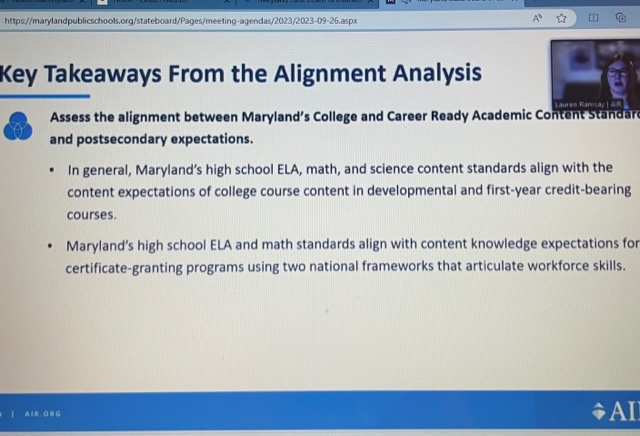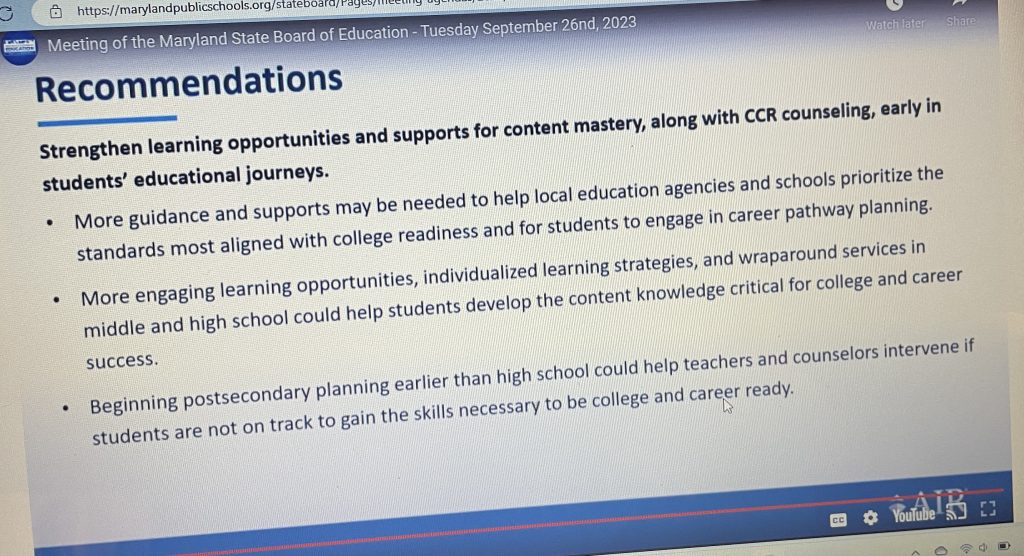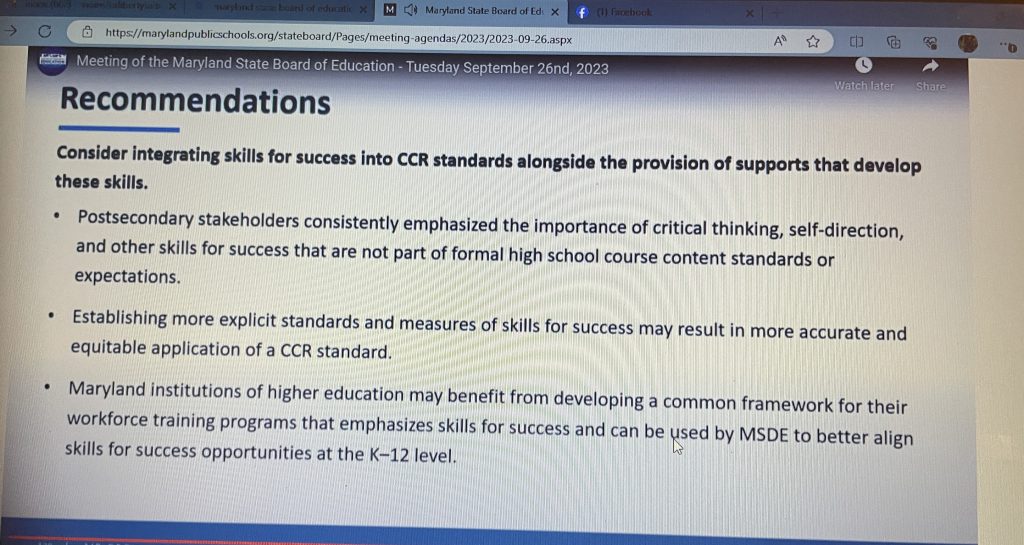I had a few hours to kill Tuesday, so I decided to watch the Maryland State Board of Education meeting. I don't recommend it unless you enjoy other stimulation like watching grass grow.
The first part of the meeting involved administrative duties including the revision of the Maryland Board of Education Governance and Operations manual. Most of the changes centered around State Superintendents and their evaluation and notification of them being renewed or not. Does anyone wonder why those were changed? Can you say "Mohammad Choudhury"?
Part of the meeting was the announcement that Superintendent Choudhury would be relieved of all duties as of October 6th and become a "consultant." More on that here:
State Board Neuters Choudhury As He Finishes His Contract - Easton Gazette
The main topic of the day was the pillar of Blueprint for Maryland's future entitled, "College and Career Readiness." From the MSDE Website:
This pillar, like so many others in the Blueprint, is at the beginning of its implementation. The problem is that no one seems to know HOW or WHAT to do to implement these pillars. For example, the state cannot define what "college and career ready status by the end of grade 10" is or how it is described. There are no standards, no benchmarks, nada. Local districts have to figure it out on their own.
In an attempt to find out what career and college ready looks like, MSDE did the following:
In spring 2022, MSDE partnered with the Maryland Assessment Research Center (MARC) at the University of Maryland to complete a short-term quantitative study to explore the relationship between students’ outcomes in high school measures and success in postsecondary coursework. In November 2022, MSDE contracted with the American Institutes of Research (AIR) to conduct a multi-part study of the CCR standard that included 1) a predictive validity analysis of the interim standard to confirm and expand on MARC’s study; and 2) a content and standards alignment analysis to determine the skills and knowledge necessary to succeed in the first year at a community college or 4-year college or university. Results from the predictive validity study were presented to the State Board of Education at the May 2023 meeting and findings from the content and standards alignment analysis were presented at the July 2023 meeting. Following the release of each interim report, MSDE and AIR engaged with a variety of stakeholders from local education agencies and higher education to communicate the findings, answer questions, and gather feedback.
Anyone wonder what that cost?
A majority of the meeting on Tuesday was a presentation by the American Institutes of Research regarding whether Maryland curriculum standards in Math, Science and English-Language Arts align with college standards in the State's community and four-year colleges.
After listening to an hour-long presentation by the woman the upper right-hand corner of the picture, this was the conclusion:

As you can see, the message is, "all is well and everything is aligned."
One of the Board members then questioned the report asking, " If all the content standards are aligned in our schools, then why are we seeing 40% of students who are ready for college and the rest getting remediation? "
Presenters gave these answers:
When the current State Superintendent Choudhury was asked, his response was that colleges needed to use more than standardized tests for entry and rely on high school GPA instead. However, it was pointed out to him that the study showed that the top three performing states in college and career readiness DID NOT use high school GPA for entry to college.
But, when asked about what education would like in five years, Choudhury, who is apparently "free to be me" since he is not returning after his contract ends, said: "The meritocracy will be gone. Standardized testing will be gone. The SAT will be gone. The Maryland Comprehensive Assessment Program will be gone. Entry will be based on competency-based learning (side note: how do you test competency if there are no tests?), portfolios, and credit for what you already know what to do. In this way, disparities between subgroups will disappear."
I wonder if he told the testing companies yet. That's going to cost them some money.
The American Research Associates had their own suggestions:


First, let me congratulate AIR for being up to date and in the know of all the educational jargon. "Educational journeys, wraparound services, equitable and stakeholders" are from page one of the education lexicon of non-specific terms that sound great and mean nothing.
Second, the recommendations this group presents are the "same old, same old." We have been aligning, emphasizing, and establishing explicit standards and measures of success for decades. We have also been offering college preparation prior to high school, more guidance, more engagement, more individualized learning and skills for success at the K-12 level. And yet, here we are.
The problem with the State Board of Education and groups like AIR who obviously make a lot of money of their data studies is that NO ONE wants to address the real problems in education right now and address those problems. Why?
First, they don't like the solutions that will work. The solution of simply allowing teachers to focus time on reading, writing, math, science etc. is just too simple, too easy. If we remove all the ancillary gender ideology, CRT, and other politically motivated divisive issues, kids might actually learn. But this solution doesn't cost enough money to allow all the grifters like AIR to feed at the public trough. And they can't distract our kids so that the elite will always be in charge.
The simple solutions also don't promote the myth of systemic racism in the education system. Most teachers, black or white, will tell you that the basic, good instruction works with ALL students. Yes, a good teacher will use different strategies on different children, but they determine these strategies based on individuals, not on stereotyped groups. A racist teacher doesn't last long in a school system, tenured or not.
They don't want to admit that students are out of control in classrooms and students who misbehave have to face real punitive consequences. Videos circulating on the internet show students throwing chairs and knocking teachers out, fighting with each other, shouting over teachers who are trying to teach, and countless other disruptions. You can't get college or career ready in the midst of chaos. But the "experts" want to pretend that counseling and a slice of pizza from a social worker will make this better.
Unions also hate the real solutions. They prefer solutions that require extra staffing which means extra memberships for them. Extra memberships mean more money and more power. Ask Cheryl Bost, the President of the Maryland State Education Association, about how much extra members mean to her and the National Education Association. Plus, if any solutions DO work then how will the whine about needing more money?
After exploring the pillar and doing some cursory discussion, the meeting concluded with everyone patting each other on the back about how what a great job they were doing with the Blueprint. In true bureaucratic style, they saw the problem, discussed the problem, admired the problem, and never solved the problem.
The incompetent leading the incompetent.
Maybe they should ask some teachers who actually work in a classroom for some answers.
What a novel thought.